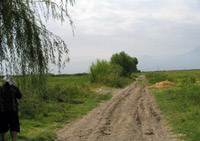“Don’t write a lot, that’s enough,” says the resident of Masis city of the Ararat Marz Henzel Darbinyan. Despite what he said, he and his neighbors started talking about the hardships they face in the village. They assured that the villagers of the Tavush, Lori, Syunik and other regions of Armenia live the same way. Although the city of Masis has turned into a city during the past couple of years, however the people still live like villagers.
“Do you see this large field? I’m the only one who sowed the crop. I sow, harvest and try to figure out where I can sell it,” says Henzel.
People living in the city always claim that villagers exaggerate about village life and that the villagers are the ones that complain the most. If you ask residents of the city, they say that agriculture is not really hard and the sun doesn’t burn that much. The residents of Masis didn’t want readers to get the impression that they are complaining a lot.
“I’ll tell you my story and you tell me if that’s a complaint or the reality. Look, how many fields are near my land? How many are sown? Why don’t they sow it? I have sown the crops and now I’ll tell you about the difficulties we face. First, it’s hard to find the equipment needed to sow the crops in the springtime. Besides that, the people driving the tractors and trucks want the salary beforehand, but most of the villagers get money during this season. The poor villager has to either get a loan, or forget about sowing his crop. Then it’s time to fertilize and irrigate. The price for one bag of fertilizer ranges from 5500-6000 AMD. How many bags of fertilizer should the villager buy so that he can fertilize the thousands of meters? When it’s time to irrigate, they don’t give us water. They only gave us water for 20 days this year. Do you realize what that means? They want the money for it before turning the water on. If you don’t pay them, they cut it off. How can we pay them? Now we have little crop and are waiting to see who will buy it from us so we can get some income. Right now, one kilogram of tomatoes costs 200 AMD, right? The resellers buy it from me for 35-40 AMD. We can’t make it to the city; that’s why we have to rent a car for 10,000 AMD and come to the market. Nobody gives any room for the villager to stop and sell his products at the market. You stop somewhere and someone comes up to you and says that that’s his spot, the same thing over and over. Can I trade like that? We don’t go to the market anymore. We just sit and wait in the village. If they don’t buy the products, we’ll just feed it to the pigs. Why don’t the sellers in the city let us sell our products so that you can buy the tomatoes for 100 AMD a kilogram and not 200?”
During the dry season this year, the Armenian government lent a helping hand to the villagers with two offers. The first has to do with water rents. Recently, the Minister of Territorial Management of Armenia Hovik Abrahamyan announced that he had warned all “Irrigation” territorial structures not to charge villagers money until they get income from product sales. Chief police officer Hayk Harutyunyan had ordered not to stop the trucks transferring vegetables. The villagers didn’t know what to say about this last one because they haven’t transferred any products and they didn’t know about the water rents.
“I was forced to pay a little. I know that the others have paid too. Of course, we would like to have paid in the fall. They forced us, so we paid. Don’t believe what you hear on television. That’s not the truth,” says Henzel.
Sometimes we hear and read that state officials help villagers by giving them loans. Besides that, they often feel a sense of pride when they say that by giving loans to villagers, they help develop small and medium businesses in Armenia. There are some reports now and then from re-cultivating factories that they’re signing contracts to accept products and give the money for tomatoes soon. However, villagers were complaining about this too.
“Go house to house and see how many people have got the loan. They don’t give the loans to villagers like us. They give the loans to the farmers or their friends. The average villager doesn’t get the loan. That’s why the villager can’t sow the crop in the spring because he doesn’t have money. We sell the tomatoes you buy for 200 AMD for 21-25 to the factories. But the factories have closed and the ones that exist are small and far,” says the neighbor Henrik.
While listening to what Henrik and Henzel had to say, Henzel’s wife Vartuhi told me not to write all that the men said.
“The villager is living the bad life. Don’t write a lot,” said Mrs. Vartuhi.

